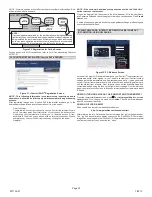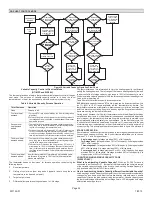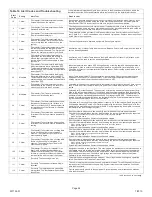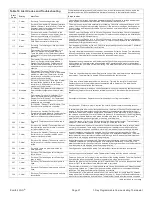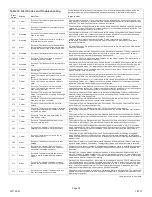
507152-01
7/2013
Page 22
9:39 am Aug 15, 2012
system devices
equipment
tests
setup
back
reset All
System
To adjust a setting,
highlight it, then press
Edit
9:39 am Aug 15, 2012
System
edit
back
Reset All
current value:
325
Low Heating Airflow
Equipment Name
Heating Airflow Control Type
Low Heating Airflow
High Heating Airflow
High Cooling Airflow
Airflow Profile - Cooling
High HP Airflow
Continuous Indoor Blower Airflow
Heating Indoor Blower OFF Delay
Low Heating Airflow
Range is 325 to 450
Default is 400, inc: 25
cancel
save
set-to
325
System
Furnace
Thermostat
2 Stage HP Unit
Zoning Control
resetAll
about
edit
Figure 36. Edit Equipment Details
STAGE DELAY AND DIFFERENTIAL SETTINGS (INSTALLER
SETTINGS)
1st Stage Differential
—Stage 1 differential is used in all thermostats. The default is
1.0°F but can be programmed between 0.5° and 3.0°F in 0.5°F increments.
From the equipment button, use the arrows to select 1st Stage Differential. Press
edit
. Use the up/down arrows to adjust to the desired setting and press
save
.
2nd Stage Differential
(where applicable)—The default is 1.0°F but can be
programmed between 0.5° and 8.0°F in 0.5°F increments.
3rd Stage Differential through 6th Stage Differential
(where applicable)—The
default is 0.5°F but can be programmed between 0.5°F and 8.0°F in 0.5°F
increments.
NOTE - Each stage's differential is based on the previous stage's differential
endpoint. For example, in cooling mode, if stage 1 differential is set to 1.0ºF, then the
system comes on 0.5ºF above set point and the 2nd differential starts at the 0.5ºF
stage 1 endpoint and extends to 2nd stage differential endpoint.
NOTE - In normal operation, the end of the cooling demand is at the set point -0.5ºF
and the end of the heating demand is at the set point +0.5ºF.
Staged Delay Timers
—default Enabled. When ON, all stage delay timers (stages 2
through 6) are enabled and will serve to bring on additional stage(s) of cooling or
heating on a timed basis (default 20 minutes) in cases when the previous stage of
heating or cooling will not raise or lower the room temperature to the set point in a
given time. When disabled is selected all stage delay timers are disabled. This
means stages are changed based on the temperature and not their timer delays.
NOTE - The 2nd Stage Delay Timer (when Staged Delay Timers is Enabled) is used
for both HEATING and COOLING. However, if the system has a variable capacity
furnace, 2nd Stage Delay Timer will only be used for COOLING (not for heating, as
the variable capacity algorithm ignores delay timers).
2nd thru 6th Stage Delay
timer (where applicable)—If Staged Delay Timers are
Enabled, the default delay is 20 minutes but can be programmed from 5 to 120
minutes in 5-minute increments. If first stage fails to advance the ambient
temperature toward the set point by 1.0°F in the programmed delay time, then the
second stage is activated.
Heat Cool Stages Locked In
—default Disabled (heat/cool stages are turned off
separately). If changed to Enabled, heat/cool stages are turned off together. Scroll
to Heat Cool Stages Locked In; press
edit
. Use arrows to select between Disabled
or Enabled. Press
save
.
Lock In 2nd stage HP by Outdoor Temp
—default Off (heat pump stage 2 operates
normally). Use this setting to lock in the 2nd stage compressor when the outdoor
temperature is at or less than the LOCK TEMP set point. Scroll to Lock In 2nd stage
HP by Outdoor Temp; press
edit
. Use arrows to select a temperature between 40
and 55ºF. Press
save
.
SMOOTH SETBACK RECOVERY (SSR)
SSR is an algorithm designed to “smoothly” reach a occupied program schedule set
point. The algorithm looks 2 hours ahead for the occupied program schedule
period's set point. If the occupied set point requires the system to turn on (present
temperature below the heat set point or above the cool set point), then SSR will
calculate a new set point. Once initiated, SSR monitors the change in room
temperature and calculates a new set point every 30 seconds. Then SSR provides
this new set point for the heating and cooling algorithms; the new set point will be
displayed on the User Interface.
SSR RULES :
1. SSR is enabled when “Smooth Setback Recovery” is set to
enabled
and the
program schedule is turned on.
2. When SSR is enabled, then it will check for a new set point every 30 seconds.
3. The SSR Target Program Schedule set point is always 2 hours ahead.
4. When SSR starts, then the Current SSR set point will equal the current
program schedule set point.
5. When a new program schedule period starts, then the New SSR set point will
equal the new program schedule period's set point, unless there are two or
more program periods within the 2 hour window. In this case, SSR will track
the highest heat set point or the lowest cool set point found in the 2 hour
window.
6. SSR will NOT run during a program schedule HOLD.
7. SSR does NOT look at the current temperature.
8. If the target program heat set point is lower than the Current SSR heat set
point, then the New SSR Heat Set point will equal the Current SSR Set point.
9. If the target program cool set point is higher than the Current SSR cool set
point, then the New SSR Cool Set point will equal the Current SSR Set point.
10. The New SSR Set point will be displayed on the User Interface.
11. SSR does NOT control the equipment.
12. SSR does NOT turn off Stage Delay Timers.
13. SSR does NOT round the newly rounded set point, but the set point shown
on the user interface is rounded.
14. SSR will NOT change the Temperature Dead band.
15. SSR will not adjust a set point to violate the Temperature Dead band.
16. SSR will not overshoot the Target Set point.
HEAT PUMP, DUAL-FUEL, DUAL-FUEL TEMPERING AND BALANCE
POINTS
IMPORTANT - The Balance Points feature requires that a sensed outdoor temperature
is provided to the thermostat. This can be either a connection to Wi-Fi (for local
temperature information) or a connection to an outdoor sensor (included in all
communicating iComfort
t
-enabled heat pumps; optional outdoor temperature sensor
X2658 for non-communicating heat pumps).
BALANCE POINTS - HEAT PUMP
The LOW and HIGH set points may be controlled by the iComfort Wi-Fi
®
thermostat
using the LOW and HIGH Balance Points feature. To enable the Balance Points
feature, go to the installer section equipment button. Scroll down to the “System”
screen, select
edit
and scroll down to Balance Points Controls. Use arrows to select
Enabled
and then press
save
. See the flowchart (Page 23) for a simplified
explanation of how balance points control system operation.
LOW BALANCE POINT
If the outside temperature is below the programmed low balance point (set by default at
25°F), compressor operation is not allowed. Since the heat pump is not as effective at a
lower outdoor temperatures, it may be more comfortable to use the auxiliary electric heat
or the furnace (in dual fuel systems, it may be more economical) to satisfy a demand for
heat. The low balance point options are from -20°F to the high balance point
temperature. The set point can be adjusted in 1.0°F steps.













